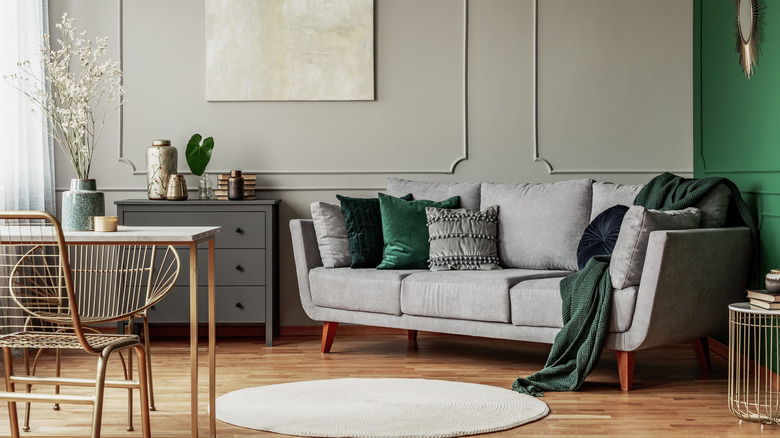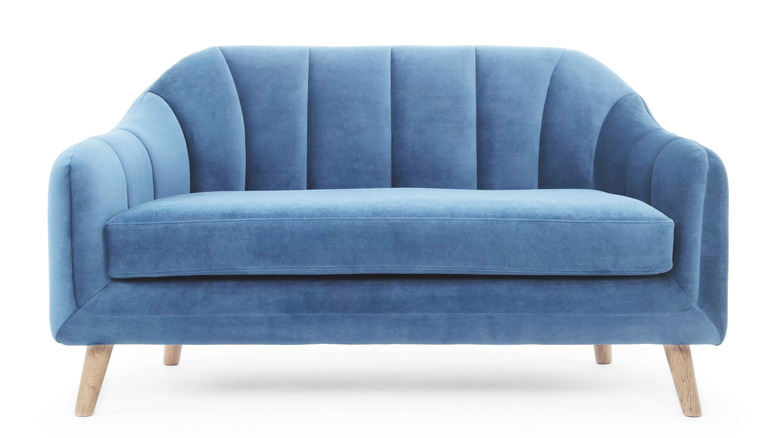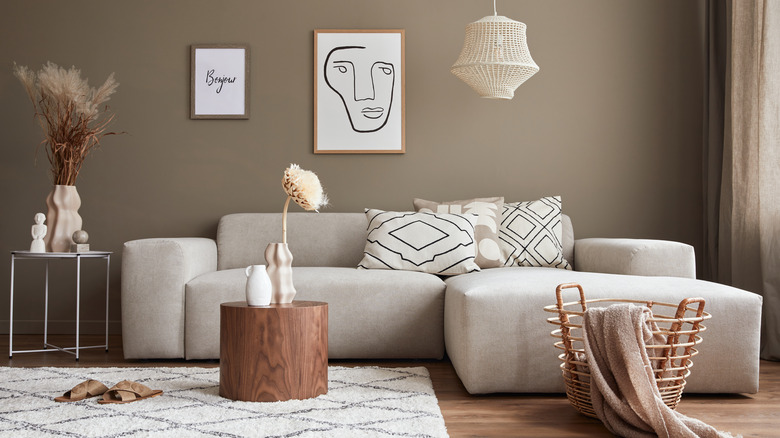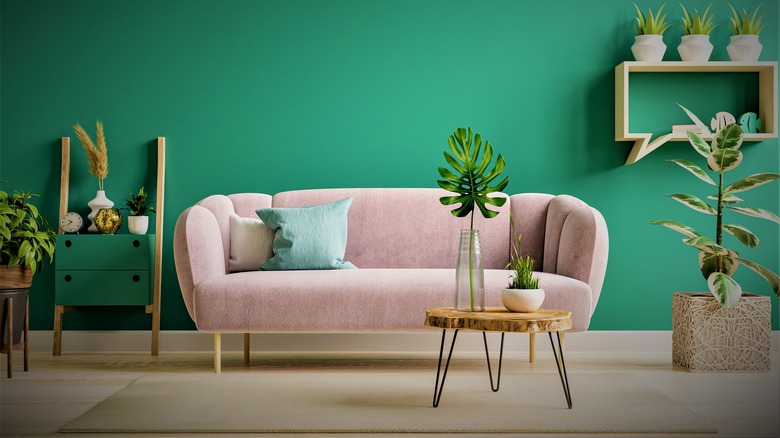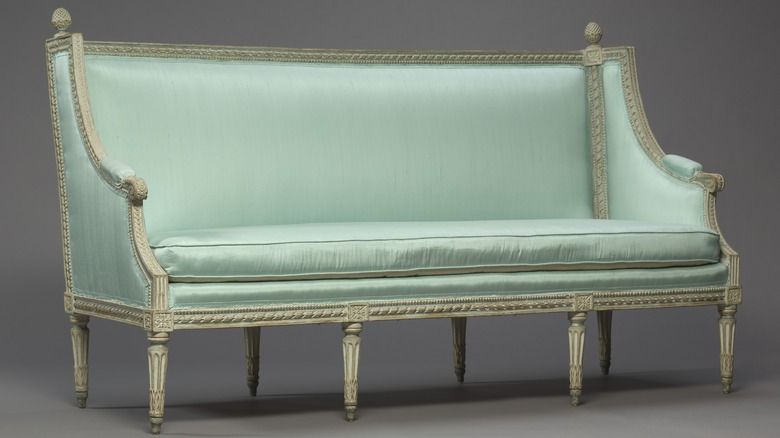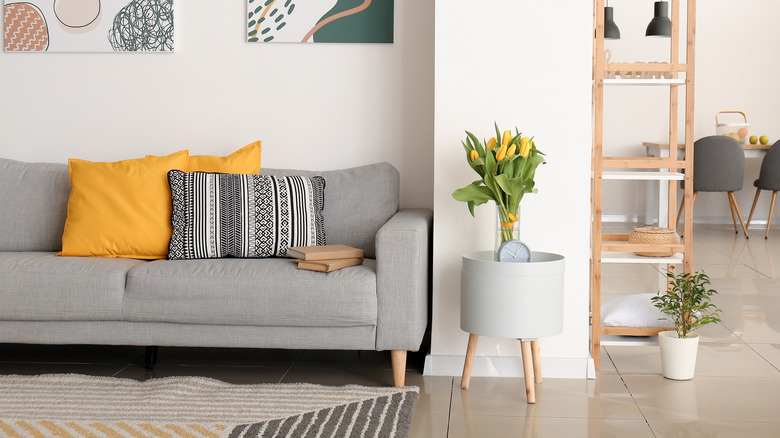Couch Vs. Settee: What's The Difference?
Furniture shopping can be confusing, especially when it comes to furniture for the living room. While a simple couch may seem good enough, stores and websites can overwhelm you with different terminology, leaving you confused and at a loss of where to start. When shopping for a couch, you will probably also come across the term settee and wonder what is the difference between the two? While the difference may be subtle, it is there. Generally, a settee can be referred to as a couch, however, not all couches are settees.
As Jennifer Taylor explains, settees are essentially cushioned sofas with backs. That is, they are very easily identifiable by their distinct lack of arms. Whereas some couch designs like the Chesterfield or the Cabriole are all about the arms, settees don't have any, and if they do, they're very slight. Additional differences in size and design also play a role and are important considerations when choosing the best seating for your living area.
How does the appearance differ?
There are no firm design rules for a couch. In fact, there is a wide array of unique couches, all primarily influenced by different moments in history, design trends, world events, and more. That being said, what we refer to as a standard couch is usually rectangular in shape, with medium-sized arms and a back that reaches to your head when sitting.
Settees are just one of these many types of couches. According to Furniture.com, settees tend to have shallower seats with taller backs, long legs, and short or no arms. Settees are often recommended for areas that aren't as lived in, like bedrooms and hallways. As mentioned, Jennifer Taylor describes settees as medium-sized couches with no arms, or a bench with a back. According to Sofa.com, settees are relatively compact and tend to be only a little bigger than a loveseat. Settees are believed to have first been designed in the Middle Ages, originally made out of wood with a carved, ornate back. Modern settees come in all types of colors and materials, though, just like couches.
Differences in size
Settees are generally considered to be medium in size, especially when compared to large couches with chaise attachments. Furnishing Tips notes that sofas tend to be around 70 to 96 inches long, whereas settees are usually only 30 to 50 inches long. They also tend to be a little thinner and shallower than standard couches.
This difference in size can actually be traced back to the settees' origin. While they are believed to have originated in the Middle Ages, they became a popular furniture staple in the 18th century, explains The Spruce. Settees were used as formal seating and were purposely a little smaller and less comfortable than an average lounging couch to amp up the air of formality. They became a staple in upper-class, wealthy homes in the 1800s, and were often used as an intimate but chaste seating option for courting. Now, they're more for accenting your living room or providing a seating option in smaller and less comfort-oriented areas of the home.
Pros and cons of couches
There are a variety of benefits and drawbacks to both couches and settees, and it essentially depends on where you're planning on putting one in your home, and what you're planning on using it for. Couches are generally larger and come in a variety of sizes, models, designs, and textiles, and they're a lot easier to find. As Furnishing Tips points out, they also tend to be deeper, more inviting, and more comfortable over long periods of sitting.
Couch size can also be a negative, as it can be hard to maneuver one into a small living space. In the same vein, those looking for space-conscious seating for areas of the home like bedrooms, offices, and hallways may find couches, even loveseats, too large and clunky. Furthermore, an overly cushioned couch can also look out of place in more formal areas like a home office.
Pros and cons of settees
On the flip side, one of the main benefits of a settee is its smaller seating option. The armless design makes it a little more discreet and streamlined than a simple loveseat, too. Settees add a certain air of formality to a room, carrying on its original legacy. Furnishing Tips describes it as a higher-end version of the simple sofa, stating that it gives off a certain luxurious look and feel.
One of the negatives, though, is that it can be quite stiff in appearance, and its shallower design makes it less comfortable to sit on. This is fine in more staunch environments but may make a family living room seem a little cold. While settees can definitely be added to areas for extra seating, they often don't look great on their own, meaning you may need the prerequisite of a couch if you intend to purchase a settee.
Recommended use of each
There aren't any hard and fast rules when it comes to how you want to decorate your interior spaces, although there are some general guidelines that can help make your home as cozy and functional as possible. While you should always follow your natural intuition when furnishing your home, it is also important to consider what each piece of furniture brings in both form and function.
Space permitting, couches are recommended in pretty much every living room. According to Rismedia's Housecall, couches are one of the most popular pieces of furniture in America, and the ones that people are willing to spend the most money on. Couches are great in any room with enough space, from lounges and family rooms to bedrooms and offices. Settees, on the other hand, are a little bit more specific. Since they tend to be smaller than the average couch, they are a great choice in hallways or as additional seating in bedrooms, offices, or similar rooms. Their general shape doesn't make them the most comfortable piece of furniture, though, and as such, it isn't necessarily the best idea to swap out your couch for a settee in small spaces.
